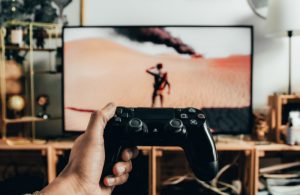The popularity of gaming has soared this year with revenue gained in 2020 predicted to top $159 billion across the globe, a 9.3% growth from last year. Plus, with the launch of the highly anticipated new, Xbox and Playstation consoles later this year will no doubt see the sale of consoles and console games increase even more.
With these exciting new consoles on the horizon, it’s time to start thinking not only about which games you’re looking forward to playing on the new systems, but also how you can improve your gaming experience. Console gamers looking for an immersive experience when playing their favourite games know the gaming experience is greatly influenced by how the visuals are depicted on the screen. Investing in a good-quality TV is essential for any gamer who wants to get the full benefit out of their gaming console. So, what should a gamer be looking for when purchasing a TV? Check out our buyer’s guide on what to look for when buying a TV for gaming.

Lag Time
Arguably the most important feature to look out for when buying a TV for gaming. Lag time refers to the amount of time between the press of a button on the console controller and the in-game action-reaction on the television. When measuring the corresponding lag time anything under 50ms is considered good, and anything under 25ms deemed excellent. If your TV’s lag time is too high it will put the gamer at a disadvantage and can be extremely off-putting while immersed in a game. If you enjoy playing multi-player games, we recommend opting for a TV with a lag time under 25ms.
Refresh Rates
Another thing to consider is the refresh rate (or frames per second, or Hz) of your TV. While high refresh rates are great, you may not need a 120Hz TV. High refresh rates are usually a trade-off for raw visual quality, and there’s a good chance that you’re already comfortable with 60 FPS or less. For competitive gamers, a new 120Hz TV is worth the splurge, but casual gamers will do fine sticking to a TV with 60 FPS.

Resolution
Currently, the latest consoles games on the market support 4K and have an output of 1080p which works well with all current recent TV models. However, with the new generation of consoles launching soon, your current TV may fall short. If gaming is a huge part of your life, buying a future proof TV is the best option. When it comes to gaming TVs, size does matter. When purchasing a 4K TV choose one that is 45 inches or more, anything smaller will dull the effects and the gaming experience. An HDR TV is also a great choice as it creates lifelike images which are noticeable on any screen size. Unlike 4K, which is a measure of resolution, HDR is a measure of contrast. HDR creates an image with dark blacks, bright whites and well-defined details, and is already supported on current gaming consoles.
OLED vs LCD
Next, you’ll have to decide between an OLED or LCD TV. OLED TVs can turn off individual pixels and don’t use a backlight, enabling them to transmit images that are crisp with high contrast. An OLED TV with a 120Hz refresh rate is the perfect choice for gaming, especially if you are looking for high-quality images and a fast response time. Of course, there is also the concern that OLED TVs are more prone to ‘burn-in’ when used for long periods at a time. Investing in a LCD TV will allow you to spend longer hours playing without worrying about the issue of burn-in.
Similarly, if you’ve decided you’re going to invest in a 120Hz high framerate TV, it’s best to opt for an LCD TV. OLED TVs can suffer from screen blur at refresh rates higher than 60Hz so it’s good to be aware of this issue if you don’t want to experience that blur while gaming. This blur is caused by the LEDs taking a few milliseconds to turn on and off.

That being said, if you don’t care about refresh rates, and you don’t leave your TV on long enough to cause burn-in then there’s no reason not to buy an OLED display. You’ll appreciate the increased depth of colour and minimal lag.
Connectivity
Most current consoles need an HDMI port to be able to work. However, the new consoles coming onto the market may shake up the industry with a whole new type of connectivity. One of the requirements to play games in 4K on one of the soon-to-be-launched consoles is a HDMI2.0 cable and port to ensure 60fps performance at 4K Ultra HD resolution. If you are purchasing a TV to game on make sure that the correct ports are available for your console of choice.
Find the best price on LCD and OLED TVs for gaming on PriceCheck now:





